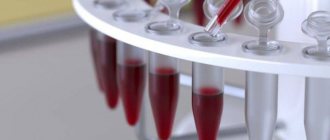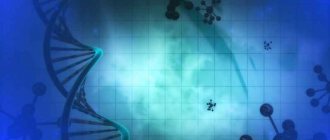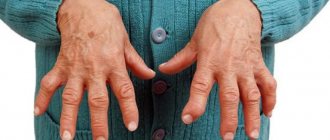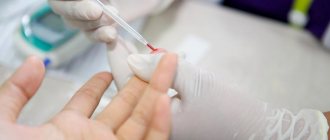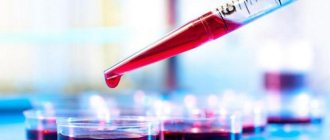The abbreviation KSR refers to a set of serological studies, during which it is possible to confirm or exclude the presence of the causative agent of syphilis in the human body. The danger of this disease is that it can be asymptomatic for a long time (even years). Meanwhile, irreversible changes occur in the human body during this time, in particular, internal organs are destroyed.
Indications
CSR is a laboratory test that is prescribed to patients with symptoms of syphilis. The following signs indicate the active life of Treponema pallidum (the causative agent of the disease).
- Presence of chancre on the genitals. This is a dense and painless neoplasm with smooth edges.
- Insomnia.
- Constant feeling of weakness.
- Loss of appetite, including loss of appetite.
- Frequent episodes of headaches.
- Increase in body temperature to subfebrile levels.
- Painful sensations in muscles and joints.
- Pale rash all over the body.
It is important to know that the DAC blood test is a test that is prescribed not only if there are symptoms of syphilis. There are other indications for its implementation.
- Promiscuous sexual intercourse.
- Diagnosis of health status before any type of surgery. Doctors need to know whether they need to take precautions to avoid contracting a dangerous disease.
- The period of bearing a child. DAC is a test, a positive result of which is a reason to terminate the pregnancy. This is due to the fact that the causative agent of syphilis poses a serious threat to the fetus.
- Pregnancy planning. As part of conscious preparation for bearing a child, a CSR analysis is required. This allows you to timely identify pathology and take all necessary measures to combat it.
In addition, the study is carried out as part of annual preventive examinations.
general description
Antibodies produced by the immune system appear in the blood of an infected person. The causative agent of the disease, Treponema pallidum, contains the antigen cardiolipin, which causes the production of antibodies detected by RW. A positive Wasserman reaction indicates the presence of such antibodies in a person’s blood, and on this basis a conclusion is made about the presence of the disease.
The hemolysis reaction is an indicator of the result of the study in the RSC. The reaction involves two components: sheep red blood cells and hemolytic serum. Hemolytic serum is obtained by immunizing a rabbit with sheep red blood cells. It is inactivated for 30 minutes at a temperature of 56°C. The results of RSC are evaluated depending on the presence or absence of hemolysis in the test tubes. The presence of hemolysis is explained by the fact that if there are no syphilitic antibodies in the test serum, then the antigen-antibody reaction does not occur, and all the complement goes to the sheep erythrocyte-hemolysin reaction. And if there are specific antibodies, the complement is completely spent on the antigen-antibody reaction and hemolysis does not occur.
All ingredients for the Wasserman reaction are taken in the same volume - 0.5 or 0.25 ml. For strong fixation of complement on a specific complex, a mixture of the test serum, antigen and complement is placed in a thermostat at a temperature of 37° for 45-60 minutes. (phase I reaction), after which a hemolytic system consisting of sheep erythrocytes and hemolytic serum is added (phase II reaction). Next, the tubes are again placed in a thermostat for 30-60 minutes until hemolysis occurs in the control, in which the antigen is replaced with physiological solution, and instead of the test serum, physiological solution is added. Antigens for the Wasserman reaction are produced in finished form, indicating the titer and dilution method.
The maximum positivity of the Wasserman reaction is usually indicated by the number of crosses: ++++ (strongly positive reaction) - indicates a complete delay in hemolysis; +++ (positive reaction) - corresponds to a significant delay in hemolysis, ++ (weakly positive reaction) - evidence of a partial delay in hemolysis, + (doubtful reaction) - corresponds to a slight delay in hemolysis. Negative RW is characterized by complete hemolysis in all test tubes.
If a doctor suspects a patient has a false positive result for the Wasserman reaction, he can prescribe a number of additional tests that are usually used in diagnosing sexually transmitted diseases.
- Syphilis.
- Suspicion of syphilis in people who are in contact with patients with syphilis.
- Pregnancy.
- Drug addiction.
- Abortion.
- Fever accompanied by enlargement of regional lymph nodes.
- Initial visit to the clinic.
- Admission to hospital for treatment.
- Treatment in a psychiatric or neurological hospital.
- Donation of blood, tissue, sperm, and other body secretions.
- Work in the service sector, trade, medical care, social and educational sectors.
Blood for RW is donated only on an empty stomach. The last meal should be no later than 6 hours before the test. The medical worker sits the patient down or places him on the couch and takes 8-10 ml of blood from the cubital vein.
If an analysis needs to be done on an infant, the sample is taken from the cranial or jugular vein.
You should stop drinking alcohol 1-2 days before the test. It is also not recommended to eat fatty foods - they can distort the result. During the period of preparation for the analysis, you should refrain from taking digitalis medications.
The analysis result will be false if:
- the patient has an elevated body temperature,
- the person is sick with an infectious disease or has just recovered from it,
- a woman is menstruating,
- pregnant in the last weeks before giving birth,
- the first 10 days after birth,
- the first 10 days of a baby's life.
Preparation
The result of the analysis directly depends on compliance with the doctor’s recommendations. The study requires careful preparation.
- The last meal before donating biological material should take place no later than 10-12 hours. At the same time, dinner should be easily digestible. As for pregnant women and people suffering from diabetes, you should refrain from drinking any liquids other than pure still water.
- 2 days before the study, it is necessary to abandon physical activity or reduce its intensity to a minimum.
- You need to stop taking medications a few days before. If this is impossible for health reasons, you must inform your doctor about this.
CSR is a study, the result of which can even be influenced by the psycho-emotional state. Before donating blood, doctors recommend sitting for 15 minutes near the office and trying to relax and calm down as much as possible.
Diagnosis of syphilis
If syphilis is not treated, the patient's internal organs begin to deteriorate after a few years. A person can suffer for decades, and death will be painful. An analysis for syphilis allows you to diagnose the disease in a timely manner and prescribe treatment, primarily antibiotic therapy. How long it will take for treatment depends on the stage of the disease and the correct treatment: at the initial stage, you can get rid of the disease in three to four months. Syphilis cannot be treated on its own.
In order for a doctor to make an accurate diagnosis of syphilis, additional and accurate information is needed, so the patient is sent for an examination consisting of several types of tests.
One of the most common ways to detect treponemes is to examine them under a dark field microscope. Thanks to this method, a specialist can see a “live” microorganism in action. You can also track the movements of treponema pallidum, as well as see all the features of its structure. To begin such an analysis, it is necessary to obtain material that can be taken from the surface of the chancre or foci of erosion.
CSR for syphilis is used to diagnose all forms of this sexually transmitted disease, in the examination of patients who have had unprotected sex with an infected person, people suspected of having Treponema pallidum, as well as pregnant women - to exclude the presence of Treponema pallidum in the body.
In the case of a positive CSR reaction to syphilis as a result of the analysis, to complete the picture, the venereologist prescribes a number of additional tests, and only after receiving and reviewing the results, makes a diagnosis and determines an effective treatment program. Today, medicine provides the opportunity to conduct the following additional tests:
- RV (Wassermann reaction). Can often give a false positive result.
- RIF (immunofluorescence reaction or Koons method). There are three methods: direct, indirect and complement. The Koons reaction helps identify microbial antigens or detect the presence of antibodies.
Thanks to the CSR and additional research, there should be no errors in diagnosis. This means that a venereologist will be able to outline a productive treatment program, predict the course of the disease and its curability. After all, the sooner you start treatment, the greater the likelihood that this disease will not cause you irreparable harm to the whole body. Syphilis is a dangerous and contagious disease, which if left untreated will inevitably lead to death.
Serological diagnosis of syphilis
The standard components of the complex of serological reactions (CSR) for ascertaining a syphilitic infection are currently supplemented by treponemal reactions: RIBT (treponema pallidum immobilization reaction), RIF (immunofluorescence reaction). The Wasserman reaction (RW, PB) is based on the phenomenon of complement fixation.
Wasserman reaction. Complement is bound by a complex (lipoid antigen and reagin of the test serum). To indicate the formed complex, a hemolytic system (sheep red blood cells and hemolytic serum) is used.
sharply positive - 4; positive - 3; weakly positive - 2 or 1; negative - -.
It is also important to stage the reaction using a quantitative method, i.e. with different dilutions of serum (1:10; 1:20, etc. up to 1:320). The large number of standard serological reactions is explained by the antigenic mosaic nature of Treponema pallidum, due to which a corresponding multiplicity of antibodies (complement-fixing, agglutinins, precipitins, immobilins, antibodies that cause immune fluorescence, etc.) appears in the blood serum of patients.
At each stage of syphilis, certain antibodies may predominate and, therefore, reactions with some antigens may already be positive, while with others they may still be negative. In addition, the relative specificity of standard serological reactions makes it necessary to use not one of them, but a complex of reactions, in order to avoid diagnostic errors.
CSRs become positive at the end of the 3rd or during the 4th week after the appearance of chancre. These reactions are sharply positive and in a significant dilution of sera in almost all patients with secondary fresh (98-99%), secondary recurrent (100%), tertiary active (70-80%) and tertiary latent (50-60%) syphilis.
However, CSR is not a strictly specific set of reactions for syphilis. They may be positive in patients with leprosy, tuberculosis, brucellosis, malaria, lupus erythematosus, as well as in cases of pneumonia, liver diseases, cancer, after drinking alcohol, fatty foods, during pregnancy, especially in the second half, as well as during the first 2 weeks after childbirth. With age, the number of nonspecific false-positive DCS results increases.
For a substantiated diagnosis of syphilis, along with CSR data, clinical data, test results for Treponema pallidum in the manifest manifestations of primary and secondary syphilis, data from other serological reactions - RIBT and RIF are taken into account.
https://www.youtube.com/watch?v=DS__h4FsVhc
RIBT is based on the phenomenon of immobilization of Treponema pallidum by immobilisin-type antibodies found in the blood serum of patients with syphilis. A suspension of pale treponema obtained from tissues of syphilitic orchitis of a rabbit is used as an antigen for RIBT. Treponema pallidums, after adding the patient’s blood serum to them, stop moving, i.e.
their immobilization occurs. The results of the reaction are assessed as a percentage: positive RIBT is stated when immobilization from 51 to 100% of Treponema pallidum, weakly positive - from 31 to 50%, doubtful - from 21 to 30% and negative - from 0 to 20%. The reaction is carried out under conditions of anaerobiosis. Immobilisins appear in the blood serum of patients later than other antibodies, so RIBT becomes positive later than CSR and RIF.
RIBT is the most specific of the existing reactions to syphilis. Its main purpose is to recognize false-positive results when performing CSR. This is especially important for patients in whom syphilis occurs latently without external manifestations, but with damage to internal organs or the nervous system.
RIBT is of particular importance in recognizing false-positive CSR results in pregnant women. It should be remembered that nonspecific positive results of RIBT are also possible in patients with sarcoidosis, lupus erythematosus, tuberculosis, cirrhosis of the liver, etc. However, in these diseases, RIBT is weakly positive (from 30 to 50%) and never reaches 100%).
RIF is a more sensitive reaction, so it is positive already in the primary seronegative period of syphilis in 80% of patients. In terms of specificity, RIF is inferior to RIBT, which does not allow it to replace RIBT, although its technique is much simpler. The reaction is carried out in several modifications: RIF-10, RIF-200 and RIF-abs.
(absorbed). RIF-10 is more sensitive, while RIF-200 and RIF-abs. more specific. The principle of the reaction is that a specific antigen (treponema pallidum) is combined with the patient’s blood serum (antibodies) and anti-species fluorescent serum (rabbit serum against human globulins combined with fluorescein, a substance that glows under ultraviolet light).
With a positive reaction, a yellow-green glow of pale treponema can be seen in a fluorescent microscope, since they are surrounded by fluorescent antibodies clinging to them. The degree of luminescence is assessed by pluses, as with CSR. A positive reaction is stated 4, 3 and 2.
Express method (microreaction on glass). In this reaction, as well as in CSR, cardiolipin antigen is used, one drop of which is mixed with 2-3 drops of the blood serum of the person being examined in the wells of a special glass plate. The reaction proceeds by the precipitation mechanism. The total duration of the reaction is min.
The result is assessed by the amount of precipitation and the size of the flakes; the severity of the reaction is indicated by pluses: 4, 3, etc., like the DAC. The microreaction on glass is less specific for patients with syphilis than RV, but is slightly superior in sensitivity. False-positive results are obtained more often with the express method than with the RT method.
Therefore, this method is approved for use only as a selection reaction during mass examinations of the population, clinical examination and examination of patients in clinical diagnostic laboratories of somatic hospitals. A definitive diagnosis of syphilis based on this method is prohibited. Only the express method cannot be used when examining donors, pregnant women, or for monitoring after treatment of patients with syphilis.
Collection of biomaterial and its examination
The algorithm for collecting venous blood is standard:
- the healthcare worker applies a tourniquet to the forearm (just above the elbow);
- the specialist treats the skin in the intended puncture area with an antiseptic;
- the final stage is the insertion of a needle into the vein, removal of the tourniquet and collection of biomaterial.
The tube is labeled in the presence of the patient and sent to the laboratory. There are several methods for studying biomaterials. Currently, the most common blood test is the CSR MR. Biological material is examined for a microprecipitation reaction, the essence of which is the formation and precipitation of an antigen-antibody complex.
Cells, whose task is to destroy the provoking agent, are not immediately produced by the body's immune system. IgM antibodies are produced within two weeks from the moment of infection with Treponema pallidum, IgG - after about 1 month.
A CSR blood test allows you to determine the duration of the disease, identify pathology even in a latent form, and also evaluate the effectiveness of previously prescribed treatment.
Analysis for syphilis: types, how to take it, explanation || Blood test for csr mr what is it
Syphilis is caused by a bacterium called Treponema pallidum.
It can penetrate the body even through minor injuries, and although it is transmitted mainly through sexual contact, a person can also become infected through household items.
However, you should know that the bacterium dies after half an hour at temperatures above 48 degrees. This is why sterilization is important.
There are primary, secondary, latent and tertiary stages of syphilis. The first signs of the disease are an ulcer on the skin, which disappears after about 5 weeks. After two months, signs of secondary syphilis appear in the form of rashes, ulcers and nodules. One of the severe complications of this form is kidney damage.
If the disease is not treated, tertiary syphilis develops. It manifests itself after five years, when internal organs are destroyed. The nervous, cardiovascular systems, spinal cord and brain are affected. The kidneys, liver, stomach, and intestines fail.
The situation is especially dangerous if a person is sick with HIV. Like syphilis, HIV is most often transmitted through sexual contact and is difficult to treat.
At the same time, patients with syphilis are at risk of contracting HIV, and patients with HIV are at risk of contracting syphilis.
If an HIV-infected person catches syphilis, the effectiveness of treatment depends on the stage of the disease: the longer a person is sick with HIV, the greater the risk of developing severe complications of syphilis (especially if the HIV-infected person is not treated).
How is the analysis taken?
If a finger prick blood test shows the likelihood of Treponema pallidum, a more detailed, extended study needs to be conducted. In this case, blood for syphilis is taken only from a vein: only in this case can a correct negative or positive result be obtained.
This type of analysis, such as a smear, is ineffective in the case of syphilis, as with HIV. The smear does not contain the pathogen at all stages of the disease.
Types of research
To determine antibodies to Treponema pallidum in the blood, the following tests are used:
- RIF or FTA (immunofluorescence reaction) - the absorption reaction of fluorescent antibodies is determined.
- RPHA or TPHA (passive hemagglutination reaction) is a test for syphilis that detects IgM and IgG antibodies.
- ELISA or ELISA - the name stands for enzyme-linked immunosorbent assay; it determines the quantitative content of IgG and IgM antibodies.
Syphilis can be detected by treponemal and non-treponemal tests. The first test for syphilis detects antibodies in the blood against Treponema pallidum antigens. The second detects antibodies against tissues that the bacterium has destroyed.
ELISA is an effective test method that is done not only to determine the presence of infection, but also to determine the stage of the disease. In addition, ELISA can answer the question of whether a given person has ever had syphilis. The sensitivity of ELISA can reach 90%.
ELISA analysis allows you to determine antibodies to Treponema pallidum: immunoglobulins - G, M, A. Their concentration allows you to trace the disease process in its dynamics.
Immediately after infection, IgA antibodies are produced to fight the bacterium, and IgM antibodies are produced two weeks later. After a month, IgG appears. When the clinical symptoms of the disease begin to appear, the blood for syphilis shows a sufficient amount of antibodies of all three types.
Research shows that syphilis-specific IgM antibodies decrease dramatically after effective treatment. The peculiarity of IgG antibodies is that the test for syphilis detects them even a long time after treatment and throughout the patient’s life. Therefore, a positive ELISA result does not always mean the presence of the causative agent of syphilis.
Passive hemagglutination reaction
RPGA refers to specific treponemal methods for identifying the causative agent of treponema pallidum. When performing an RPHA analysis, during the reaction of antibodies and red blood cells, the latter stick together and precipitate. How many precipitated red blood cells are formed during RPHA is directly proportional to the amount of treponema antibodies.
The specificity of RPGA allows it to be used to confirm the diagnosis of other tests, such as RPR or MRP. At the same time, RPGA is not as sensitive to the stages of syphilis as ELISA.
Therefore, RPGA and ELISA must be considered in conjunction with each other. A false positive RPHA result is possible in 2.5% of cases.
This is possible due to the similarity of immunoglobulins with other antibodies that are released in some other diseases, for example, autoimmune diseases.
A set of serological reactions (CSR), one of which is known as the Wassermann reaction, is a valuable diagnostic method. It allows both to identify the infection and determine the stage of the disease. A blood test for syphilis KSR must be supplemented with treponemal-specific methods of analysis (RIBD and ELISA).
The CSR is not a specific test for syphilis: a positive CSR is possible in patients with tuberculosis, malaria, autoimmune diseases, oncology, during pregnancy and other conditions. It is mandatory to take a test for syphilis during pregnancy, since the presence of this disease in a pregnant woman can lead to a miscarriage or the birth of a child with a congenital disease.
The express method is an accelerated version of the Wasserman reaction. When performing a rapid test for syphilis, a cardiolipid antigen is also used, which is mixed with serum in the recess of a special glass plate.
How long it takes to complete a test often depends on the technique used. Typically, the express method takes about half an hour.
The reaction result of the express method is assessed in the same way as the ESR, with positive numbers from 0 to 4. The sensitivity of the express method, although superior to the ESR, can give a false positive result due to another disease.
ORS and UMSS are another variant of the Wasserman reaction or express method. The abbreviation UMSS stands for the accelerated method for latent syphilis. ORS stands for selection reaction to syphilis. When performing ORS, the same reagents are used as in the Wasserman reaction.
How to evaluate the result
To obtain accurate data, blood must be tested for syphilis on an empty stomach. The concept of fasting means that at least eight hours should pass between meals.
If the patient came to take the test on an empty stomach, but last ate food less than eight hours ago, he needs to wait. The concept of an empty stomach also means that you should not drink any drinks other than still water before the test.
Tests are taken on an empty stomach not only to diagnose syphilis: this is a general rule.
A negative test for syphilis is indicated by a “-” sign. But a negative result does not always mean that there is no pathogen in the body. More often, a false negative result occurs when decoding rapid tests based on the Wasserman reaction. Therefore, you can relax only when the data from all tests give a negative result.
The highest trust rating among syphilis patients is the PCR result. If the PCR is positive, it means it is truly positive. If the decoding is negative, then it is negative.
But PCR can show a positive result even after successful treatment, since it can determine the presence of both living and dead bacteria.
Other tests may also give a false result after successful treatment.
Anonymity of treatment
People, especially men, do not often express a desire to be regularly examined by a doctor. As for syphilis, the reason for this may be either the symptoms of a sluggish disease that do not manifest themselves, or shame, or a reluctance for others to know about the disease.
Therefore, many people often agree to undergo an anonymous examination, but want to receive a guarantee that the treatment will also be truly anonymous. Of course, there is no problem getting tested for syphilis anonymously.
They arise when the patient wants to be treated anonymously. The fact is that a person is a carrier of a dangerous venereal disease and can infect both people close to him and a stranger.
Therefore, under no circumstances should you hesitate and during treatment you must follow all the doctor’s instructions.
Source: https://komp-off.ru/analiz-krovi-na-ksr-mr-chto-eto/
Interpretation of results
A venereologist deciphers the KSR blood test. However, anyone can interpret the results. This is due to the fact that decoding the CSR is not difficult, the research is qualitative, that is, its outcome can be positive or negative.
In the first case, it is customary to talk about the presence of syphilis in the patient’s body (primary, secondary or tertiary). A positive result can also be detected within 1 year after therapy.
If during the study treponema pallidum was not detected in the biomaterial, and the patient does not have any alarming symptoms, this indicates the absence of syphilis. But it is important to know that the result may be negative with early infection and the tertiary form of the disease.
How is the microprecipitation reaction carried out?
Material for research: blood from a finger, venous blood, cerebrospinal fluid. It is advisable to take blood on an empty stomach.
Precipitation microreaction scheme To carry out the reaction, the classic VDRL antigen (cardiolipin + lecithin + cholesterol) is used with the addition of charcoal particles for visual assessment of the test results. The blood serum under study is mixed on glass with the antigen. If the serum contains reagin antibodies, black flakes (flocculants) are formed ), which are a sign of a positive reaction. In the absence of reagin antibodies in the serum, the formation of flakes (flocculation) does not occur.
Results of microreaction to syphilis If anti-lipid antibodies are detected - a positive reaction (when performing a quantitative modification, titers are from 1: 2 to 1: 320 and above. In the absence of anti-lipid antibodies - a negative reaction. With low antibody titers - a questionable reaction
Factors that may lead to a false positive result
The research is not always reliable. Its result may be positive if the patient has the following diseases and conditions:
- diabetes mellitus;
- malignant neoplasms;
- tuberculosis;
- autoimmune pathologies;
- viral hepatitis;
- pneumonia;
- enterovirus infection;
- scarlet fever;
- infectious mononucleosis;
- gout;
- malaria;
- alcoholism;
- antiphospholipid syndrome;
- eosinophilic infiltrate in the lungs.
In addition, a false positive result can be observed in babies 7-8 days after birth. A similar situation is typical for the post-vaccination period.
If you receive a questionable result, you must take the blood test again.
